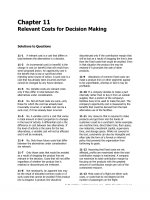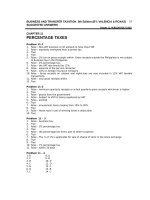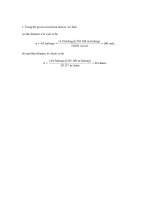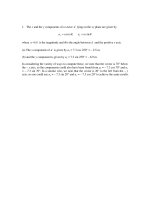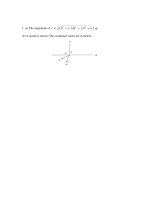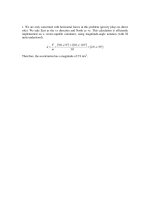Solution manual vector mechanics engineers dynamics 8th beer chapter 11
Bạn đang xem bản rút gọn của tài liệu. Xem và tải ngay bản đầy đủ của tài liệu tại đây (14.89 MB, 180 trang )
COSMOS: Complete Online Solutions Manual Organization System
Chapter 11, Solution 2.
2
x = t3 − (t − 2) m
(a)
v=
dx
= 3t 2 − 2 ( t − 2 ) m/s
dt
a=
dv
= 6t − 2 m/s 2
dt
Time at a = 0.
0 = 6t0 − 2 = 0
t0 =
(b)
1
3
t0 = 0.333 s W
Corresponding position and velocity.
3
2
⎛1⎞
⎛1
⎞
x = ⎜ ⎟ − ⎜ − 2 ⎟ = − 2.741 m
⎝3⎠
⎝3
⎠
x = − 2.74 m W
2
⎛1⎞
⎛1
⎞
v = 3 ⎜ ⎟ − 2 ⎜ − 2 ⎟ = 3.666 m/s
⎝3⎠
⎝3
⎠
Vector Mechanics for Engineers: Statics and Dynamics, 8/e, Ferdinand P. Beer, E. Russell Johnston, Jr.,
Elliot R. Eisenberg, William E. Clausen, David Mazurek, Phillip J. Cornwell
© 2007 The McGraw-Hill Companies.
v = 3.67 m/s W
COSMOS: Complete Online Solutions Manual Organization System
Chapter 11, Solution 3.
Position:
x = 5t 4 − 4t 3 + 3t − 2 ft
Velocity:
v=
dx
= 20t 3 − 12t 2 + 3 ft/s
dt
Acceleration:
a=
dv
= 60t 2 − 24t ft/s 2
dt
When t = 2 s,
4
3
x = ( 5 )( 2 ) − ( 4 )( 2 ) − ( 3)( 2 ) − 2
3
2
v = ( 20 )( 2 ) − (12 )( 2 ) + 3
2
a = ( 60 )( 2 ) − ( 24 )( 2 )
Vector Mechanics for Engineers: Statics and Dynamics, 8/e, Ferdinand P. Beer, E. Russell Johnston, Jr.,
Elliot R. Eisenberg, William E. Clausen, David Mazurek, Phillip J. Cornwell
© 2007 The McGraw-Hill Companies.
x = 52 ft W
v = 115 ft/s W
a = 192 ft/s 2 W
COSMOS: Complete Online Solutions Manual Organization System
Chapter 11, Solution 4.
Position:
x = 6t 4 + 8t 3 − 14t 2 − 10t + 16 in.
Velocity:
v=
dx
= 24t 3 + 24t 2 − 28t − 10 in./s
dt
Acceleration:
a=
dv
= 72t 2 + 48t − 28 in./s 2
dt
When t = 3 s,
4
3
2
x = ( 6 )( 3) + ( 8 )( 3) − (14 )( 3) − (10 )( 3) + 16
3
2
v = ( 24 )( 3) + ( 24 )( 3) − ( 28 )( 3) − 10
2
a = ( 72 )( 3) + ( 48 )( 3) − 28
Vector Mechanics for Engineers: Statics and Dynamics, 8/e, Ferdinand P. Beer, E. Russell Johnston, Jr.,
Elliot R. Eisenberg, William E. Clausen, David Mazurek, Phillip J. Cornwell
© 2007 The McGraw-Hill Companies.
x = 562 in. !
v = 770 in./s !
a = 764 in./s 2 !
COSMOS: Complete Online Solutions Manual Organization System
Chapter 11, Solution 5.
Position:
x = 500sin kt mm
Velocity:
v=
dx
= 500k cos kt mm/s
dt
Acceleration:
a=
dv
= − 500k 2 sin kt mm /s 2
dt
When t = 0.05 s,
and
k = 10 rad/s
kt = (10 )( 0.05 ) = 0.5 rad
x = 500sin ( 0.5 )
v = ( 500 )(10 ) cos ( 0.5 )
2
a = − ( 500 )(10 ) sin ( 0.5 )
Vector Mechanics for Engineers: Statics and Dynamics, 8/e, Ferdinand P. Beer, E. Russell Johnston, Jr.,
Elliot R. Eisenberg, William E. Clausen, David Mazurek, Phillip J. Cornwell
© 2007 The McGraw-Hill Companies.
x = 240 mm !
v = 4390 mm/s !
a = − 24.0 × 103 mm/s 2 !
COSMOS: Complete Online Solutions Manual Organization System
Chapter 11, Solution 6.
(
)
x = 50sin k1t − k2t 2 mm
Position:
k2 = 0.5 rad/s 2
Where
k1 = 1 rad/s
Let
θ = k1t − k2t 2 = t − 0.5t 2 rad
dθ
= (1 − t ) rad/s
dt
x = 50sin θ mm
Position:
and
d 2θ
= −1 rad/s 2
dt 2
and
dx
dθ
= 50cosθ
mm/s
dt
dt
dv
a=
dt
v=
Velocity:
Acceleration:
2
a = 50cosθ
When v = 0,
d 2θ
⎛ dθ ⎞
2
− 50sin θ ⎜
⎟ mm/s
dt
dt 2
⎝
⎠
either
cosθ = 0
dθ
=1− t = 0
dt
Over 0 ≤ t ≤ 2 s, values of cosθ are:
t =1s
or
t (s)
0
0.5
1.0
1.5
2.0
θ ( rad )
0
0.375
0.5
0.375
0
cosθ
1.0
0.931
0.878
0.981
1.0
No solutions cosθ = 0 in this range.
For t = 1 s,
2
θ = 1 − ( 0.5 )(1) = 0.5 rad
x = 50sin ( 0.5 )
a = 50cos ( 0.5 )( −1) − 50sin ( 0.5 )( 0 )
Vector Mechanics for Engineers: Statics and Dynamics, 8/e, Ferdinand P. Beer, E. Russell Johnston, Jr.,
Elliot R. Eisenberg, William E. Clausen, David Mazurek, Phillip J. Cornwell
© 2007 The McGraw-Hill Companies.
x = 24.0 mm W
a = − 43.9 mm/s 2 W
COSMOS: Complete Online Solutions Manual Organization System
Chapter 11, Solution 7.
Given:
x = t 3 − 6t 2 + 9t + 5
Differentiate twice.
v=
dx
= 3t 2 − 12t + 9
dt
a=
dv
= 6t − 12
dt
(a)
v=0
When velocity is zero.
3t 2 − 12t + 9 = 3 ( t − 1)( t − 3) = 0
t = 1 s and t = 3 s W
(b)
Position at t = 5 s.
3
2
x5 = ( 5 ) − ( 6 )( 5 ) + ( 9 )( 5 ) + 5
x5 = 25 ft W
Acceleration at t = 5 s.
a5 = ( 6 )( 5 ) − 12
a5 = 18 ft/s 2 W
Position at t = 0.
x0 = 5 ft
Over 0 ≤ t < 1 s
x is increasing.
Over 1 s < t < 3 s
x is decreasing.
Over 3 s < t ≤ 5 s
x is increasing.
Position at t = 1 s.
3
2
x1 = (1) − ( 6 )(1) + ( 9 )(1) + 5 = 9 ft
Position at t = 3 s.
3
2
x3 = ( 3) − ( 6 )( 3) + ( 9 )( 3) + 5 = 5 ft
Distance traveled.
At t = 1 s
d1 = x1 − x0 = 9 − 5 = 4 ft
At t = 3 s
d3 = d1 + x3 − x1 = 4 + 5 − 9 = 8 ft
At t = 5 s
d5 = d3 + x5 − x3 = 8 + 25 − 5 = 28 ft
d5 = 28 ft W
Vector Mechanics for Engineers: Statics and Dynamics, 8/e, Ferdinand P. Beer, E. Russell Johnston, Jr.,
Elliot R. Eisenberg, William E. Clausen, David Mazurek, Phillip J. Cornwell
© 2007 The McGraw-Hill Companies.
COSMOS: Complete Online Solutions Manual Organization System
Chapter 11, Solution 8.
3
x = t 2 − ( t − 2 ) ft
v=
(a)
dx
2
= 2t − 3 ( t − 2 ) ft/s
dt
Positions at v = 0.
2
2t − 3 ( t − 2 ) = − 3t 2 + 14t − 12 = 0
t=
−14 ± (14) 2 − (4)(− 3)(−12)
(2)(− 3)
t1 = 1.1315 s and t2 = 3.535 s
(b)
At t1 = 1.1315 s,
x1 = 1.935 ft
x1 = 1.935 ft W
At t2 = 3.535 s,
x2 = 8.879 ft
x2 = 8.879 ft W
Total distance traveled.
At t = t0 = 0,
x0 = 8 ft
At t = t4 = 4 s,
x4 = 8 ft
Distances traveled.
0 to t1:
d1 = 1.935 − 8 = 6.065 ft
t1 to t2:
d 2 = 8.879 − 1.935 = 6.944 ft
t2 to t4:
d3 = 8 − 8.879 = 0.879 ft
Adding,
d = d1 + d 2 + d3
Vector Mechanics for Engineers: Statics and Dynamics, 8/e, Ferdinand P. Beer, E. Russell Johnston, Jr.,
Elliot R. Eisenberg, William E. Clausen, David Mazurek, Phillip J. Cornwell
© 2007 The McGraw-Hill Companies.
d = 13.89 ft W
COSMOS: Complete Online Solutions Manual Organization System
Chapter 11, Solution 9.
a = 3e− 0.2t
v
t
∫ 0 dv = ∫ 0 a dt
v −0=∫
t
3e− 0.2t dt
0
3
=
e− 0.2t
− 0.2
(
)
(
t
0
v = −15 e− 0.2t − 1 = 15 1 − e− 0.2t
At t = 0.5 s,
(
v = 15 1 − e− 0.1
x
)
)
v = 1.427 ft/s W
t
∫ 0 dx = ∫ 0 v dt
t
0
(
x − 0 = 15∫ 1 − e
(
− 0.2t
)
x = 15 t + 5e− 0.2t − 5
At t = 0.5 s,
(
t
1 − 0.2t ⎞
⎛
dt = 15 ⎜ t +
e
⎟
0.2
⎝
⎠0
)
x = 15 0.5 + 5e− 0.1 − 5
)
Vector Mechanics for Engineers: Statics and Dynamics, 8/e, Ferdinand P. Beer, E. Russell Johnston, Jr.,
Elliot R. Eisenberg, William E. Clausen, David Mazurek, Phillip J. Cornwell
© 2007 The McGraw-Hill Companies.
x = 0.363 ft W
COSMOS: Complete Online Solutions Manual Organization System
Chapter 11, Solution 10.
Given:
a = − 5.4sin kt ft/s 2 ,
t
v0 = 1.8 ft/s, x0 = 0,
t
v − v0 = ∫ 0 a dt = − 5.4 ∫ 0 sin kt dt =
v − 1.8 =
Velocity:
0
v = 1.8cos kt ft/s
t
x−0=
When t = 0.5 s,
t
5.4
( cos kt − 1) = 1.8cos kt − 1.8
3
t
x − x0 = ∫ 0 v dt = 1.8 ∫ 0 cos kt dt =
Position:
5.4
cos kt
k
k = 3 rad/s
1.8
sin kt
k
t
0
1.8
( sin kt − 0 ) = 0.6sin kt
3
x = 0.6sin kt ft
kt = ( 3)( 0.5 ) = 1.5 rad
v = 1.8cos1.5 = 0.1273 ft/s
x = 0.6sin1.5 = 0.5985 ft
Vector Mechanics for Engineers: Statics and Dynamics, 8/e, Ferdinand P. Beer, E. Russell Johnston, Jr.,
Elliot R. Eisenberg, William E. Clausen, David Mazurek, Phillip J. Cornwell
© 2007 The McGraw-Hill Companies.
v = 0.1273 ft/s W
x = 0.598 ft W
COSMOS: Complete Online Solutions Manual Organization System
Chapter 11, Solution 11.
Given:
a = − 3.24sin kt − 4.32 cos kt ft/s 2 ,
x0 = 0.48 ft,
k = 3 rad/s
v0 = 1.08 ft/s
t
t
t
v − v0 = ∫ 0 a dt = − 3.24 ∫ 0 sin kt dt − 4.32 ∫ 0 cos kt dt
v − 1.08 =
=
t
3.24
cos kt
k
0
−
t
4.32
sin kt
k
0
3.24
4.32
( cos kt − 1) −
( sin kt − 0 )
3
3
= 1.08cos kt − 1.08 − 1.44sin kt
Velocity:
v = 1.08cos kt − 1.44sin kt ft/s
t
t
t
x − x0 = ∫ 0 v dt = 1.08 ∫ 0 cos kt dt − 1.44 ∫ 0 sin kt dt
x − 0.48 =
1.08
sin kt
k
t
0
+
1.44
cos kt
k
t
0
1.08
1.44
( sin kt − 0 ) +
( cos kt − 1)
3
3
= 0.36sin kt + 0.48cos kt − 0.48
=
Position:
When t = 0.5 s,
x = 0.36sin kt + 0.48cos kt ft
kt = ( 3)( 0.5 ) = 1.5 rad
v = 1.08cos1.5 − 1.44sin1.5 = −1.360 ft/s
x = 0.36sin1.5 + 0.48cos1.5 = 0.393 ft
Vector Mechanics for Engineers: Statics and Dynamics, 8/e, Ferdinand P. Beer, E. Russell Johnston, Jr.,
Elliot R. Eisenberg, William E. Clausen, David Mazurek, Phillip J. Cornwell
© 2007 The McGraw-Hill Companies.
v = −1.360 ft/s !
x = 0.393 ft !
COSMOS: Complete Online Solutions Manual Organization System
Chapter 11, Solution 12.
a = kt mm/s 2
Given:
At t = 0,
v = 400 mm/s;
at t = 1 s,
where k is a constant.
v = 370 mm/s,
x = 500 mm
1
v
t
t
2
∫ 400 dv = ∫ 0 a dt = ∫ 0 kt dt = 2 kt
v − 400 =
1 2
kt
2
v = 400 +
or
1
2
k (1) = 370,
2
At t = 1 s,
v = 400 +
Thus
v = 400 − 30t 2 mm/s
v7 = 400 − ( 30 )( 7 )
At t = 7 s,
When v = 0,
400 − 30t 2 = 0.
Then t 2 = 13.333 s2 ,
1 2
kt
2
k = − 60 mm/s3
2
v7 = −1070 mm/s W
t = 3.651 s
For 0 ≤ t ≤ 3.651 s,
v>0
and
x is increasing.
For t > 3.651 s,
v<0
and
x is decreasing.
x
t
t
2
∫ 500 dx = ∫ 1 v dt = ∫ 1 ( 400 − 30t ) dt
(
x − 500 = 400t − 10t 3
)
t
1
= 400t − 10t 3 − 390
Position:
x = 400t − 10t 3 + 110 mm
At t = 0,
x = x0 = 110 mm
At t = 3.651 s,
x = xmax = ( 400 )( 3.651) − (10 )( 3.651) + 110 = 1083.7 mm
At t = 7 s,
x = x7 = ( 400 )( 7 ) − (10 )( 7 ) + 110
3
3
x7 = − 520 mm W
Distances traveled:
Over 0 ≤ t ≤ 3.651 s,
d1 = xmax − x0 = 973.7 mm
Over 3.651 ≤ t ≤ 7 s,
d 2 = xmax − x7 = 1603.7 mm
Total distance traveled:
d = d1 + d 2 = 2577.4 mm
Vector Mechanics for Engineers: Statics and Dynamics, 8/e, Ferdinand P. Beer, E. Russell Johnston, Jr.,
Elliot R. Eisenberg, William E. Clausen, David Mazurek, Phillip J. Cornwell
© 2007 The McGraw-Hill Companies.
d = 2580 mm W
COSMOS: Complete Online Solutions Manual Organization System
Chapter 11, Solution 13.
Determine velocity.
v
t
t
∫ − 0.15 dv = ∫ 2 a dt = ∫ 2 0.15 dt
v − ( −0.15 ) = 0.15t − ( 0.15 )( 2 )
v = 0.15t − 0.45 m/s
At t = 5 s,
When v = 0,
v5 = ( 0.15 )( 5 ) − 0.45
0.15t − 0.45 = 0
t = 3.00 s
For 0 ≤ t ≤ 3.00 s,
v ≤ 0,
x is decreasing.
For 3.00 ≤ t ≤ 5 s,
v ≥ 0,
x is increasing.
Determine position.
v5 = 0.300 m/s W
x
t
t
∫ −10 dx = ∫ 0 v dt = ∫ 0 ( 0.15t − 0.45) dt
(
x − ( −10 ) = 0.075t 2 − 0.45t
)
t
0
= 0.075t 2 − 0.45t
x = 0.075 t 2 − 0.45t − 10 m
2
x5 = ( 0.075 )( 5 ) − ( 0.45 )( 5 ) − 10 = −10.375 m
At t = 5 s,
x5 = −10.38 m W
At t = 0,
x0 = −10 m (given)
At t = 3.00 s,
x3 = xmin = ( 0.075 )( 3.00 ) − ( 0.45 )( 3.00 ) − 10 = −10.675 mm
2
Distances traveled:
Over 0 ≤ t ≤ 3.00 s,
d1 = x0 − xmin = 0.675 m
Over 3.00 s < t < 5 s,
d 2 = x5 − xmin = 0.300 m
Total distance traveled:
d = d1 + d 2 = 0.975 m
Vector Mechanics for Engineers: Statics and Dynamics, 8/e, Ferdinand P. Beer, E. Russell Johnston, Jr.,
Elliot R. Eisenberg, William E. Clausen, David Mazurek, Phillip J. Cornwell
© 2007 The McGraw-Hill Companies.
d = 0.975 m W
COSMOS: Complete Online Solutions Manual Organization System
Chapter 11, Solution 14.
a = 9 − 3t 2
Given:
Separate variables and integrate.
v
t
2
∫ 0 dv = ∫ a dt = ∫ 0 ( 9 − 3t ) dt = 9
(
v − 0 = 9 t − t3
(a)
When v is zero.
v = t 9 − t2
)
t (9 − t 2 ) = 0
t = 0 and t = 3 s (2 roots)
(b)
t =3sW
Position and velocity at t = 4 s.
x
t
t
3
∫ 5 dx = ∫ 0 v dt = ∫ 0 ( 9t − t ) dt
x−5=
9 2 1 4
t − t
2
4
x=5+
At t = 4 s,
⎛9⎞ 2 ⎛1⎞ 4
x4 = 5 + ⎜ ⎟ ( 4 ) − ⎜ ⎟ ( 4 )
⎝2⎠
⎝4⎠
(
v4 = ( 4 ) 9 − 42
(c)
9 2 1 4
t − t
2
4
)
x4 = 13 m W
v4 = − 28 m/s W
Distance traveled.
Over 0 < t < 3 s,
v is positive, so x is increasing.
Over 3 s < t ≤ 4 s,
v is negative, so x is decreasing.
At t = 3 s,
⎛9⎞ 2 ⎛1⎞ 4
x3 = 5 + ⎜ ⎟ ( 3) − ⎜ ⎟ ( 3) = 25.25 m
⎝2⎠
⎝4⎠
At t = 3 s
d3 = x3 − x0 = 25.25 − 5 = 20.25 m
At t = 4 s
d 4 = d3 + x4 − x3 = 20.25 + 13 − 25.25 = 32.5 m
Vector Mechanics for Engineers: Statics and Dynamics, 8/e, Ferdinand P. Beer, E. Russell Johnston, Jr.,
Elliot R. Eisenberg, William E. Clausen, David Mazurek, Phillip J. Cornwell
© 2007 The McGraw-Hill Companies.
d 4 = 32.5 m W
COSMOS: Complete Online Solutions Manual Organization System
Chapter 11, Solution 15.
Separate variables
Integrate using
dv
= kt 2
dt
a=
Given:
dv = kt2 dt
v = –10 m/s when t = 0
and v = 10 m/s when t = 2 s.
10
2 2
∫ −10 dv = ∫ 0 kt dt
v
10
− 10
1 3
kt
3
=
t
0
1
[(10) − (−10)] = 3 k ⎡⎣⎢( 2 )3 − 0⎤⎦⎥
(a)
Solving for k,
(b)
Equations of motion.
k=
( 3)( 20 )
k = 7.5 m/s 4 W
8
Using upper limit of v at t,
v
v
−10
1
= kt 3
3
t
⎛1⎞
v + 10 = ⎜ ⎟ ( 7.5 ) t 3
⎝3⎠
0
v = −10 + 2.5 t 3 m/s W
dx
= v = −10 + 2.5 t 3
dt
Then,
Separate variables and integrate using x = 0 when t = 2 s.
(
)
dx = −10 + 2.5 t 3 dt
∫
x
dx
0
t
2
(
)
= ∫ −10 + 2.5 t 3 dt
x − 0 = ⎡⎣ −10 t + 0.625 t 4 ⎤⎦
t
2
4
= ⎡⎣ −10 t + 0.0625 t ⎦ − ⎡⎢( −10 )( 2 ) + ( 0.625 )( 2 ) ⎤⎥
⎣
⎦
4⎤
= −10 t + 0.625 t 4 − [ −10]
x = 10 − 10t + 0.625t 4 m W
Vector Mechanics for Engineers: Statics and Dynamics, 8/e, Ferdinand P. Beer, E. Russell Johnston, Jr.,
Elliot R. Eisenberg, William E. Clausen, David Mazurek, Phillip J. Cornwell
© 2007 The McGraw-Hill Companies.
COSMOS: Complete Online Solutions Manual Organization System
Chapter 11, Solution 16.
a = 40 − 160 x = 160 ( 0.25 − x )
Note that a is a given function of x.
(a) Note that v is maximum when a = 0, or x = 0.25 m
Use v dv = a dx = 160 ( 0.25 − x ) dx with the limits
v = 0.3 m/s when x = 0.4 m and v = vmax when x = 0.25 m
vmax
0.25
∫ 0.3 v dv = ∫ 0.4 160 ( 0.25 − x ) dx
2
( 0.25 − x )
vmax
0.32
−
= −160
2
2
2
2
0.25
0.4
⎡
( − 0.15)2 ⎤⎥ = 1.8
= −160 ⎢0 −
2
⎢⎣
⎥⎦
2
vmax
= 3.69 m 2 /s 2
vmax = 1.921 m/s W
(b) Note that x is maximum or minimum when v = 0.
Use v dv = a dx = 160 ( 0.25 − x ) with the limits
v = 0.3 m/s
when x = 0.4 m,
and
v = 0 when x = xm
xm
0
∫ 0.3 v dv = ∫ 0.4 160 ( 0.25 − x ) dx
2
0.3)
(
0−
2
2
0.25 − x )
(
= −160
2
xm
2
= − 80 ( 0.25 − xm ) + ( 80 )( − 0.15 )
2
0.4
( 0.25 − xm )2 = 0.02306
0.25 − xm = ± 0.1519 m
xm = 0.0981 m and 0.402 m W
Vector Mechanics for Engineers: Statics and Dynamics, 8/e, Ferdinand P. Beer, E. Russell Johnston, Jr.,
Elliot R. Eisenberg, William E. Clausen, David Mazurek, Phillip J. Cornwell
© 2007 The McGraw-Hill Companies.
COSMOS: Complete Online Solutions Manual Organization System
Chapter 11, Solution 17.
a = 100 ( 0.25 − x ) m/s 2
a is a function of x:
Use v dv = a dx = 100 ( 0.25 − x ) dx with limits v = 0 when x = 0.2 m
∫ 0 v dv = ∫ 0.2100 ( 0.25 − x ) dx
v
x
x
1 2
1
2
v − 0 = − (100 )( 0.25 − x )
2
2
0.2
= − 50 ( 0.25 − x ) + 0.125
2
So
v 2 = 0.25 − 100 ( 0.25 − x )
Use
Integrate:
dx = v dt
t
x
∫ 0 dt = ± ∫ 0.2
Let u = 20 ( 0.25 − x ) ;
So
Solve for u.
or
dt =
2
v = ± 0.5 1 − 400 ( 0.25 − x )
or
2
dx
dx
=
2
v
± 0.5 1 − 400 ( 0.25 − x )
dx
0.5 1 − 400 ( 0.25 − x )
when x = 0.2 u = 1
2
and du = − 20dx
1
1 −1
π
= m sin −1 u = m
t = m∫
sin u −
2
10
10
2
10 1 − u
1
u
1
u
du
sin −1 u =
π
2
m 10t
π
u = sin m 10t = cos ( ± 10t ) = cos10t
2
u = cos 10t = 20 ( 0.25 − x )
continued
Vector Mechanics for Engineers: Statics and Dynamics, 8/e, Ferdinand P. Beer, E. Russell Johnston, Jr.,
Elliot R. Eisenberg, William E. Clausen, David Mazurek, Phillip J. Cornwell
© 2007 The McGraw-Hill Companies.
COSMOS: Complete Online Solutions Manual Organization System
Solve for x and v.
x = 0.25 −
v=
Evaluate at t = 0.2 s.
1
sin10t
2
x = 0.25 −
v=
1
cos10t
20
1
cos ( (10 )( 0.2 ) )
20
1
sin ( (10 )( 0.2 ) )
2
Vector Mechanics for Engineers: Statics and Dynamics, 8/e, Ferdinand P. Beer, E. Russell Johnston, Jr.,
Elliot R. Eisenberg, William E. Clausen, David Mazurek, Phillip J. Cornwell
© 2007 The McGraw-Hill Companies.
x = 0.271 m W
v = 0.455 m/s W
COSMOS: Complete Online Solutions Manual Organization System
Chapter 11, Solution 18.
Note that a is a given function of x
Use
(
)
(
)
v dv = a dx = 600 x 1 + kx 2 dx = 600 x + 600kx3 dx
Using the limits
v = 7.5 ft/s
and
v = 15 ft/s
15
0.45
∫ 7.5 v dv = ∫ 0
⎡ v2 ⎤
⎢ ⎥
⎣2⎦
(15)2
2
−
15
7.5
when x = 0.45 ft,
( 600x + 600kx ) dx
3
⎡ 600 2 600 4 ⎤
=⎢
x +
kx ⎥
4
⎣ 2
⎦
( 7.5)2
2
when x = 0,
2
0.45
0
= ( 300 )( 0.45 ) + (150 ) k ( 0.45 )
4
84.375 = 60.75 + 6.1509k
Solving for k ,
Vector Mechanics for Engineers: Statics and Dynamics, 8/e, Ferdinand P. Beer, E. Russell Johnston, Jr.,
Elliot R. Eisenberg, William E. Clausen, David Mazurek, Phillip J. Cornwell
© 2007 The McGraw-Hill Companies.
k = 3.84 ft −2 W
COSMOS: Complete Online Solutions Manual Organization System
Chapter 11, Solution 19.
Note that a is a given function of x.
(
)
v dv = a dx = 800 x + 3200 x3 dx
Use
Using the limit v = 10 ft/s when x = 0,
v
x
3
∫10 v dv = ∫ 0 ( 800 x + 3200 x ) dx
v 2 (10 )
−
= 400 x 2 + 800 x 4
2
2
2
v 2 = 1600 x 4 + 800 x 2 + 100
Let u = x 2
v 2 = 1600u 2 + 800u + 100 = 1600 ( u − u1 )( u − u2 ) ,
Then
1600u 2 + 800u + 100 = 0
where u1 and u2 are the roots of
Solving the quadratic equation,
u1,2 =
− 800 ±
(800 )2 − ( 4 )(1600 )(100 )
( 2 )(1600 )
=
− 800 ± 0
= − 0.25 ± 0
3200
u1 = u2 = − 0.25 ft 2
So
Taking square roots,
(
)
(
)
v 2 = 1600 ( u + 0.25 ) = 1600 x 2 + 0.52
2
2
ft 2 /s 2
v = ± 40 x 2 + 0.52 ft/s
Vector Mechanics for Engineers: Statics and Dynamics, 8/e, Ferdinand P. Beer, E. Russell Johnston, Jr.,
Elliot R. Eisenberg, William E. Clausen, David Mazurek, Phillip J. Cornwell
© 2007 The McGraw-Hill Companies.
COSMOS: Complete Online Solutions Manual Organization System
Use
dx = v dt
40dt = ±
t
dt =
or
dx
x + 0.52
x
x=0
)
when
t=0
dx
1
x
=±
tan −1
2
0.5
0.5
x + 0.5
2
40t = ± 2.0 tan −1 ( 2 x )
2 x = ± tan ( 20t )
v=
(
Use limit
2
40∫ 0 dt = ± ∫ 0
dx
dx
=±
2
v
40 x + 0.52
tan −1 ( 2 x ) = ± 20t
or
x = ± 0.5 tan ( 20t )
or
dx
= ± 0.5 sec2 ( 20t ) ( 20 ) = ± 10 sec2 ( 20t )
dt
At t = 0, v = ± 10 ft/s, which agrees with the given data if the minus sign is rejected.
Thus,
At t = 0.05 s,
v = 10 sec 2 ( 20t ) ft/s,
and
x = 0.5 tan ( 20t ) ft
20t = 1.0 rad
v = 10sec2 (1.0 ) =
10
cos 2 1.0
x = 0.5 tan (1.0 )
Vector Mechanics for Engineers: Statics and Dynamics, 8/e, Ferdinand P. Beer, E. Russell Johnston, Jr.,
Elliot R. Eisenberg, William E. Clausen, David Mazurek, Phillip J. Cornwell
© 2007 The McGraw-Hill Companies.
v = 34.3 ft/s W
x = 0.779 ft W
COSMOS: Complete Online Solutions Manual Organization System
Chapter 11, Solution 20.
7
a = 12 x − 28 = 12 x − m/s 2
3
Note that a is a given function of x.
7
Use v dv = a dx = 12 x − dx with the limits v = 8 m/s when x = 0.
3
∫
v
v dv
8
v2
2
x
x
0
7
= 12∫
− dx
3
v
8
12
7
= x −
2
3
2
x
0
2
2
v 2 82 12
7
7
−
=
x − −
2
2
2
3
3
2
2
2
7
7
4
7
v = 8 + 12 x − − = 12 x − −
3
3
3
3
2
2
2
7
4
v = ± 12 x − −
3
3
Reject minus sign to get v = 8 m/s at x = 0.
(a) Maximum value of x.
v = 0 when x = xmax
2
7
4
12 x − − = 0
3
3
x−
7
1
=±
3
3
2
or
7
1
x − 3 = 9
xmax = 2 m
and
xmax =
8
2
m=2 m
3
3
Now observe that the particle starts at x = 0 with v > 0 and reaches x = 2 m. At x = 2 m, v = 0 and
2
a < 0, so that v becomes negative and x decreases. Thus, x = 2 m is never reached.
3
xmax = 2 m !
Vector Mechanics for Engineers: Statics and Dynamics, 8/e, Ferdinand P. Beer, E. Russell Johnston, Jr.,
Elliot R. Eisenberg, William E. Clausen, David Mazurek, Phillip J. Cornwell
© 2007 The McGraw-Hill Companies.
COSMOS: Complete Online Solutions Manual Organization System
(b) Velocity when total distance traveled is 3 m.
The particle will have traveled total distance d = 3 m when d − xmax = xmax − x or 3 − 2 = 2 − x
or x = 1 m.
2
7
4
Using v = − 12 x − − , which applies when x is decreasing, we get
3
3
2
7
4
v = − 12 1 − − = − 20
3
3
Vector Mechanics for Engineers: Statics and Dynamics, 8/e, Ferdinand P. Beer, E. Russell Johnston, Jr.,
Elliot R. Eisenberg, William E. Clausen, David Mazurek, Phillip J. Cornwell
© 2007 The McGraw-Hill Companies.
v = − 4.47 m/s !
COSMOS: Complete Online Solutions Manual Organization System
Chapter 11, Solution 21.
(
a = k 1 − e− x
Note that a is a function of x.
(
)
)
Use v dv = a dx = k 1 − e− x dx with the limits v = 9 m/s when x = −3 m, and v = 0 when x = 0.
0
0
−x
∫ 9 v dv = ∫ − 3 k (1 − e ) dx
⎛ v2 ⎞
⎜⎜ ⎟⎟
⎝ 2⎠
0−
0
(
= k x + e− x
9
)
0
−3
92
= k ⎡⎣0 + 1 − ( − 3) − e3 ⎤⎦ = −16.0855k
2
k = 2.52 m/s 2 W
k = 2.5178
(a)
(
)
(
)
Use v dv = a dx = k 1 − e− x dx = 2.5178 1 − e− x dx with the limit v = 0 when x = 0.
∫ 0 v dv = ∫ 0 2.5178 (1 − e
v
x
−x
v2
= 2.5178 x + e− x
2
(
)
) dx
(
x
(
)
= 2.5178 x + e− x − 1
0
)
(
v 2 = 5.0356 x + e− x − 1
)
v = ± 2.2440 x + e− x − 1
1/2
(b) Letting x = −2 m,
(
)
v = ± 2.2440 − 2 + e2 − 1
1/ 2
= ± 4.70 m/s
Since x begins at x = − 2 m and ends at x = 0, v > 0.
Reject the minus sign.
v = 4.70 m/s W
Vector Mechanics for Engineers: Statics and Dynamics, 8/e, Ferdinand P. Beer, E. Russell Johnston, Jr.,
Elliot R. Eisenberg, William E. Clausen, David Mazurek, Phillip J. Cornwell
© 2007 The McGraw-Hill Companies.
COSMOS: Complete Online Solutions Manual Organization System
Chapter 11, Solution 22.
a=v
v
dv
= 6.8 e−0.00057 x
dx
x
∫ 0 v dv = ∫ 0 6.8 e
−0.00057 x
dx
v2
6.8
e−0.00057 x
−0=
2
− 0.00057
(
= 11930 1 − e−0.00057 x
x
0
)
When v = 30 m/s.
( 30 )2
2
(
= 11930 1 − e−0.00057 x
)
1 − e−0.00057 x = 0.03772
e−0.00057 x = 0.96228
− 0.00057 x = ln (0.96228) = − 0.03845
x = 67.5 m W
Vector Mechanics for Engineers: Statics and Dynamics, 8/e, Ferdinand P. Beer, E. Russell Johnston, Jr.,
Elliot R. Eisenberg, William E. Clausen, David Mazurek, Phillip J. Cornwell
© 2007 The McGraw-Hill Companies.
COSMOS: Complete Online Solutions Manual Organization System
Chapter 11, Solution 23.
a=v
Given:
dv
= − 0.4v
dx
dv
= − 0.4
dx
or
Separate variables and integrate using v = 75 mm/s when x = 0.
v
x
∫ 75 dv = − 0.4∫ 0
v − 75 = − 0.4 x
(a) Distance traveled when v = 0
0 − 75 = − 0.4x
x = 187.5 mm W
(b) Time to reduce velocity to 1% of initial value.
v = (0.01)(75) = 0.75
t = − 2.5ln
0.75
75
Vector Mechanics for Engineers: Statics and Dynamics, 8/e, Ferdinand P. Beer, E. Russell Johnston, Jr.,
Elliot R. Eisenberg, William E. Clausen, David Mazurek, Phillip J. Cornwell
© 2007 The McGraw-Hill Companies.
t = 11.51 s W

